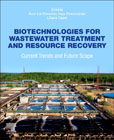
Biotechnologies for Wastewater Treatment and Resource Recovery: Current Trends and Future Scope
Srivastav, Arun Lal
Zinicovscaia, Inga
Cepoi, Liliana
Biotechnologies for Wastewater Treatment and Resource Recovery: Current Trends and Future Scope presents the most up-to-date insights into the water crisis stemming from wastewater production. Edited by experts in the field, the chapters are structured around different types of bioremediation approaches (phytoremediation, myco-remediation, bio-stimulation, bio-augmentation, rhizoremediation, etc.) all applied in the context of wastewater treatment. This comprehensive resource equips students, research scholars, and policy makers with a holistic understanding of wastewater treatment and resource recovery through bioremediation techniques. Abundant real-world applications and case studies empower readers to make well-informed decisions, ensuring the efficient utilization of energy and efforts in addressing this critical issue. Covers a thorough analysis of various bioremediation approaches such as: phytoremediation, myco-remediation, bio-stimulation, bio-augmentation, rhizoremediation, etc.Offers the most up-to-date information on integrated wastewater treatment using biological and physicochemical methodsIncludes case studies on bioremediation of domestic/industrial wastewater for the elimination of heavy metals/emerging water contaminants/pesticides/microplastics among others INDICE: 1. Wastewater: Generation, Treatment options, Reuse and future of resource recovery2. Significance of biological approaches/bioremediaion of wastewater treatment over physico-chemical methods: A comparative analysis3. Role of bacteria in bioremediation of wastewater and resource recovery4. Recent trends of phyto-remediation for the wastewater treatment and resource recovery5. Role of bio-refineries in wastewater treatment and bio-energy production6. Bio-augmentation for heavy metal treatment present in wastewater7. Wastewater treatment and resource recovery through Rhizoremediation8. Bioremediation of pesticides present in water: State of art and future scope9. Role of fungi in wastewater treatment: Recent trends and mechanism10. Limitations and challenges of bioremediation approach: Alternative solutions11. Integration of bioremediation and physico-chemical methods for wastewater treatment and resource recovery12. Scope of bioremediation of wastewater for emerging water contaminants like pharmaceuticals, microplastics, antibiotics etc.13. Artificial wetlands construction for controlled bioremediation of wastewater14. Valorisation of wastewater treatment through bioremediation approach15. Sustainable wastewater treatment through micro-algae and other biotic community for bioenergy production16. Role of bioremediation of wastewater in sustainable development goals and circular economy17. Role of plants as bioindicators of water pollution and treatment of water contaminations18. Role of bryophytes as biomonitors and bioindicators of water pollution and as bioremediation tools19. Application of modern tools for the real time monitoring of bioremediation approach and its advantages20. Case studies on bioremediation of domestic/industrial wastewater for the elimination of heavy metals/emerging water contaminants/pesticides/ microplastics etc.21. Case studies on bioenergy production and wastewater treatment.22. Case study on the biopolymer production through wastewater treatment using biotechnology23. Feasibility of reuse of treated wastewater through bioremediation approach for domestic or industrial applications24. Industrial scope of recovered valuable resources, types and application: Technical and Economic feasibilities”.25. Future perspectives of wastewater treatment.26. Bioremediation for emerging organic pollutants (pesticides, dyes etc): Present and Future27. Role of biotechnology in the recovery of nutrients from wastewater
- ISBN: 978-0-443-27376-6
- Editorial: Elsevier
- Encuadernacion: Rústica
- Páginas: 400
- Fecha Publicación: 01/11/2024
- Nº Volúmenes: 1
- Idioma: Inglés
